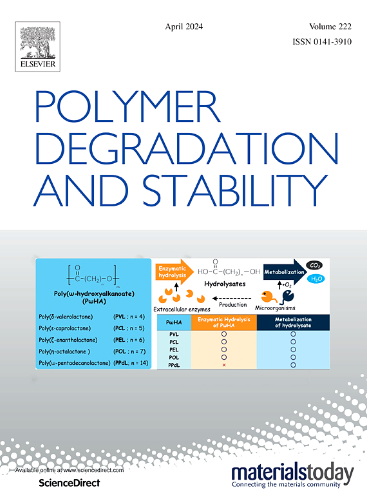Effect of hydrotalcite on the thermal stabilization performance of natural antioxidant vitamin E in Ziegler-Natta polyethylene
IF 6.3
2区 化学
Q1 POLYMER SCIENCE
引用次数: 0
Abstract
Residual catalysts in Ziegler-Natta (ZN) polyolefins usually significantly impair the effectiveness of antioxidants and the incorporation of acid scavengers is an effective method to mitigate these detrimental effects. With the increasing use of natural antioxidants like vitamin E (VE) in human-safety applications, whether their stabilizing effectiveness is affected by catalyst residues and whether traditional acid scavengers remain effective have become key issues requiring urgent resolution. This study systematically investigated the impact of hydrotalcite, a conventional acid scavenger, on VE's thermal stabilization performance in ZN polyethylene (ZN-PE). The results demonstrated that combining 500 ppm VE with 500 ppm hydrotalcite significantly extended the oxidation induction time of ZN-PE to 55.7 min at 190 °C, which surpassed the 30.7 min achieved by 1000 ppm VE alone. The changes in chemical structure, mechanical properties, and color of different samples after multiple extrusions and accelerated aging further confirmed the strong synergistic effect of VE and hydrotalcite in enhancing the thermal-oxidative stability of ZN-PE. Mechanistic investigations revealed that hydrotalcite primarily functioned by eliminating the impairment of VE’s antioxidant efficiency caused by the ZN catalyst. Additionally, hydrotalcite exhibited a certain adsorption effect on VE, which could control the release of VE, thereby extending its antioxidant efficiency in ZN-PE. These findings highlight the critical role of acid scavengers in optimizing VE performance, providing an effective strategy to optimize the use of natural antioxidants in ZN polyolefin stabilization.
水滑石对Ziegler-Natta聚乙烯天然抗氧化剂维生素E热稳定性能的影响
Ziegler-Natta (ZN)聚烯烃中的残余催化剂通常会严重影响抗氧化剂的有效性,加入酸清除剂是减轻这些有害影响的有效方法。随着维生素E (VE)等天然抗氧化剂在人体安全领域的应用越来越广泛,催化剂残留物是否影响其稳定效果以及传统的酸清除剂是否仍然有效已成为迫切需要解决的关键问题。本研究系统地研究了传统的酸清除剂水滑石对锌聚乙烯(ZN- pe)中VE热稳定性能的影响。结果表明,500 ppm VE与500 ppm水滑石的结合可显著延长ZN-PE在190℃下的氧化诱导时间,达到55.7 min,超过了单独使用1000 ppm VE的30.7 min。不同样品经过多次挤压和加速老化后的化学结构、力学性能和颜色的变化进一步证实了VE和水滑石在提高ZN-PE热氧化稳定性方面的强协同作用。机理研究表明,水滑石的主要作用是消除锌催化剂对VE抗氧化效率的损害。此外,水滑石对VE有一定的吸附作用,可以控制VE的释放,从而延长其在ZN-PE中的抗氧化效率。这些发现强调了酸清除剂在优化VE性能中的关键作用,为优化天然抗氧化剂在ZN聚烯烃稳定中的应用提供了有效的策略。
本文章由计算机程序翻译,如有差异,请以英文原文为准。
求助全文
约1分钟内获得全文
求助全文
来源期刊

Polymer Degradation and Stability
化学-高分子科学
CiteScore
10.10
自引率
10.20%
发文量
325
审稿时长
23 days
期刊介绍:
Polymer Degradation and Stability deals with the degradation reactions and their control which are a major preoccupation of practitioners of the many and diverse aspects of modern polymer technology.
Deteriorative reactions occur during processing, when polymers are subjected to heat, oxygen and mechanical stress, and during the useful life of the materials when oxygen and sunlight are the most important degradative agencies. In more specialised applications, degradation may be induced by high energy radiation, ozone, atmospheric pollutants, mechanical stress, biological action, hydrolysis and many other influences. The mechanisms of these reactions and stabilisation processes must be understood if the technology and application of polymers are to continue to advance. The reporting of investigations of this kind is therefore a major function of this journal.
However there are also new developments in polymer technology in which degradation processes find positive applications. For example, photodegradable plastics are now available, the recycling of polymeric products will become increasingly important, degradation and combustion studies are involved in the definition of the fire hazards which are associated with polymeric materials and the microelectronics industry is vitally dependent upon polymer degradation in the manufacture of its circuitry. Polymer properties may also be improved by processes like curing and grafting, the chemistry of which can be closely related to that which causes physical deterioration in other circumstances.
 求助内容:
求助内容: 应助结果提醒方式:
应助结果提醒方式:


